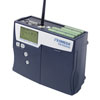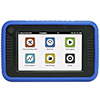Data Logger
Introduction to Data Logging equipment
Technically speaking, a
data logger (or datalogger) is any device that can be used to store data. This includes many data acquisition devices such
as plug-in boards or serial communication systems which use a computer as a real time data recording system. Nowadays, wireless transmitters are also
capable of turning a regular smart phone (or tablets) into a
mobile data logger.
Most instrument manufacturers, however,
consider a data logger a stand alone device that can read various types of electrical signals and remotely store the data in internal memory for later download
to a computer.
The advantage of data loggers is that they can operate independently of a computer, unlike many other types of data acquisition devices. Data loggers
are available in various shapes and sizes. The range includes simple economical single channel fixed function loggers to more powerful programmable
devices capable of handling hundreds of inputs.

Learn more about Data Loggers
Types of Electric Signal
- AC Voltage/Current
- AC Voltage/Current
- Light On/Off
- Shock/Acceleration
- Bridge/Strain/Load/Pressure
- Motor On/Off
- Sound
- Dew point
- PH
- Pressure
- Temperature
- Event or State
- Process Voltage/Current
- Thermistor
- Frequency
- Relative Humidity
- Thermocouple
- Level
- RTD
Choosing a Data Logger
When choosing a data logger the following parameters should be considered.
Input Signal
OMEGA offers data loggers that are compatible with most types of signals. Some data loggers are dedicated to a certain input type while others are
programmable for different types of inputs. OMEGA offers a wide range of data loggers for several types of signals, including thermocouple, sound, pH, pressure
and many more (see the "Types of Signal" for a list).
Number of Inputs
Data Loggers are available in both single and multi-channel designs. A
32 channels data logger such as
OMEGA OM-SQ2040 Series is capable of handling multiple inputs.
Size
In many applications space is a limitation. In those cases the size of the data logger may be a critical selection parameter.
OMEGA's OM-CP family of data loggers are extremely compact and include models for most input types.
Speed/Memory
In comparison to real time data acquisition systems, data loggers generally have low sample rates. This is normally because they store data in
internal memory which is limited. The higher the data rates the more memory required. Therefore when specifying a data logger it is important to
determine the sample rate and the sample duration which can be used to calculate the required memory. For example. If an application requires sample
rates of 1 per second and the test must last one hour, the data logger must be able to store 3600 samples(1 sample/sec x 1 hour x 3600 seconds/hour).
Real Time Operation
In some applications it may be desirable to display the data being collected in real time on a computer. Certain data loggers such as
OMEGA's OM-CP family support this feature.
Key Aspects to Consider When choosing a Data Logger
- Input Signal
- Number of Inputs
- Size
- Speed/Memory
- Real Time Operation
Why Choose a Data Logger Over Other Types of Data Collection Instruments?
Three types of instruments are commonly used for collecting and storing data:
- Real-Time Data Acquisition Systems
- Chart Recorders
- Data Loggers
Data loggers are normally more economical than chart recorders. They offer more flexibility and are available with a greater variety of input types.
Most data loggers collect data which may be directly transferred to a computer. Although this option is available with some recorders, it normally
adds significant expense to the recorder price.
Data acquisition systems offer a great deal of flexibility and are certainly attractive when high
sample rates are required, however, since they require connection or installation into a computer, the computer must also be present and active when
collecting the data. Data loggers can collect data independently of a computer. Data is normally collected in non-volatile memory for later download
to a computer. The computer does not need to be present during the data collection process. This makes them ideally suited for applications requiring
portability.
Choose the right Data logger
 Bluetooth Data Loggers for different inputs, temperature, humidity, pH...
Bluetooth Data Loggers for different inputs, temperature, humidity, pH...
Bluetooth wireless transmitters that connect with smart phones or tables to log and monitor and record measurements. These transmitters measure
different sensor inputs, including but not limited to pH, RTD, relative humidity. The data transmission is performed via Bluetooth wireless
technology to a smart phone or tablet with the app installed. The app will allow the smart phone to pair and set up multiple transmitters.
 Miniature Single Input Data Loggers
Miniature Single Input Data Loggers
Miniature single input data loggers are generally low cost loggers dedicated to a specific input type. These types of data loggers
are often used in the transportation industry. A typical application would be to include a temperature data logger in a shipment of
food products to insure that the food temperature does not exceed acceptable limits. In addition to temperature miniature data loggers
are available for a large variety of input types. most input types.
 Fixed Mount Multi-Channel Data Loggers
Fixed Mount Multi-Channel Data Loggers
Fixed input loggers have a fixed number of input channels which are generally dedicated for a specific type of input.
OMEGA offers fixed input data loggers ranging from one to 8 channels.
 Handheld Multi-Channel Data Loggers
Handheld Multi-Channel Data Loggers
Handheld multi-channel loggers are commonly used in applications where the data logger is to be carried from one location to another.
They are also commonly used in benchtop or laboratory environments. In addition to storing data internally some models even contain on board
printers which can produce an immediate hardcopy of the data.
 Modular Data Loggers
Modular Data Loggers
A modular data logger is configurable and expandable through the use of plug-in modules. The modules are normally field configurable and the
user has the option of adding as many channels to satisfy the application requirement.
Frequently Asked Questions
Do Data Loggers Need to be Connected to a Computer?
No, some data loggers provide an option for real-time display but all OMEGA data loggers collect data independently of the computer.
What is the Maximum Sample Rate for a Logger?
The sample rate depends on the specific model. Although most data loggers have a maximum data rate of 1 or 2 samples per second, OMEGA offers a number
of data loggers that can sample in excess of 100 samples per second.
How are the logging equipment Powered?
Most data loggers are battery powered some also offer an option for external power.
How Long Does the Battery Powered Logger Last?
The battery life of a data logger depends on a number of parameters including the specific model and sample rate. In general the faster the sample rate the
shorter the battery life. Many OMEGA data loggers feature a battery life as long as ten years.
Will the Data Logger lose its Data if the Power or Battery Fails?
Most OMEGA data loggers use non-volatile memory for data storage. This means that the data will not be lost if the power fails.
How Long Can the devices Record Data?
The recording duration is dependent on the memory capacity of the data logger and the desired sample rate. To determine the duration divide the memory
capacity(number of samples the device can record) by the sample rate. As an example assume that a given data logger
can store 10,000 samples. If it is desired to record 2 samples every minute, the data logger can run for 10,000/2 or 5,000 minutes(about 3.5 days).
If the sample rate was cut in half(1 sample per minute), the recording period would double to 7 days.
Data Logger | Related Products
↓ View this page in another language or region ↓
 CLOSE
CLOSE














 Registradores de Dados
Registradores de Dados Enregistreurs de Données
Enregistreurs de Données Registradores de Datos
Registradores de Datos Registradores de Datos
Registradores de Datos Data Loggers
Data Loggers Dataloggere
Dataloggere Enregistreurs de Données
Enregistreurs de Données Datenlogger
Datenlogger Registratori di Dati
Registratori di Dati Data Loggers
Data Loggers Datalogger
Datalogger Data Loggers
Data Loggers Data Loggers
Data Loggers Data Loggers
Data Loggers
 データロガー
データロガー 데이터로거
데이터로거 Data Loggers
Data Loggers
 Data Loggers
Data Loggers
 Data Loggers
Data Loggers
 Data Loggers
Data Loggers
 Data Loggers
Data Loggers